check engine SUZUKI IGNIS 2022 Service Manual
[x] Cancel search | Manufacturer: SUZUKI, Model Year: 2022, Model line: IGNIS, Model: SUZUKI IGNIS 2022Pages: 505, PDF Size: 8.36 MB
Page 171 of 505
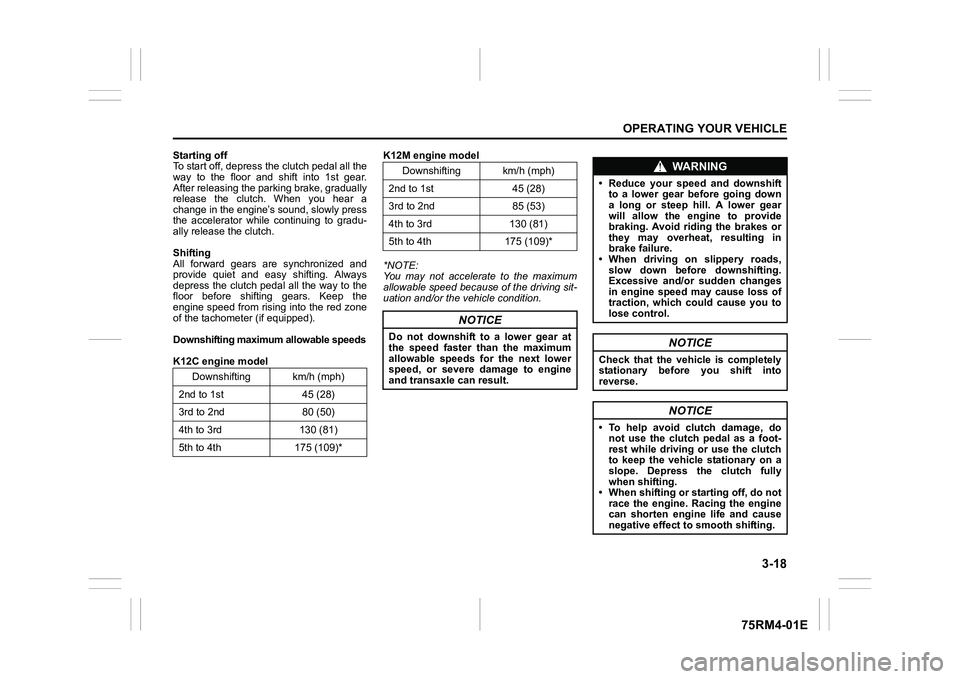
3-18
OPERATING YOUR VEHICLE
75RM4-01E
Starting off
To start off, depress the clutch pedal all the
way to the floor and shift into 1st gear.
After releasing the parking brake, gradually
release the clutch. When you hear a
change in the engine’s sound, slowly press
the accelerator while continuing to gradu-
ally release the clutch.
Shifting
All forward gears are synchronized and
provide quiet and easy shifting. Always
depress the clutch pedal all the way to the
floor before shifting gears. Keep the
engine speed from rising into the red zone
of the tachometer (if equipped).Downshifting maximum allowable speedsK12C engine modelK12M engine model
*NOTE:
You may not accelerate to the maximum
allowable speed because of the driving sit-
uation and/or the vehicle condition.
Downshifting km/h (mph)
2nd to 1st 45 (28)
3rd to 2nd 80 (50)
4th to 3rd 130 (81)
5th to 4th 175 (109)*
Downshifting km/h (mph)
2nd to 1st 45 (28)
3rd to 2nd 85 (53)
4th to 3rd 130 (81)
5th to 4th 175 (109)*
NOTICE
Do not downshift to a lower gear at
the speed faster than the maximum
allowable speeds for the next lower
speed, or severe damage to engine
and transaxle can result.
WA R N I N G
• Reduce your speed and downshift to a lower gear before going down
a long or steep hill. A lower gear
will allow the engine to provide
braking. Avoid riding the brakes or
they may overheat, resulting in
brake failure.
• When driving on slippery roads,
slow down before downshifting.
Excessive and/or sudden changes
in engine speed may cause loss of
traction, which could cause you to
lose control.
NOTICE
Check that the vehicle is completely
stationary before you shift into
reverse.
NOTICE
• To help avoid clutch damage, donot use the clutch pedal as a foot-
rest while driving or use the clutch
to keep the vehicle stationary on a
slope. Depress the clutch fully
when shifting.
• When shifting or starting off, do not race the engine. Racing the engine
can shorten engine life and cause
negative effect to smooth shifting.
Page 179 of 505
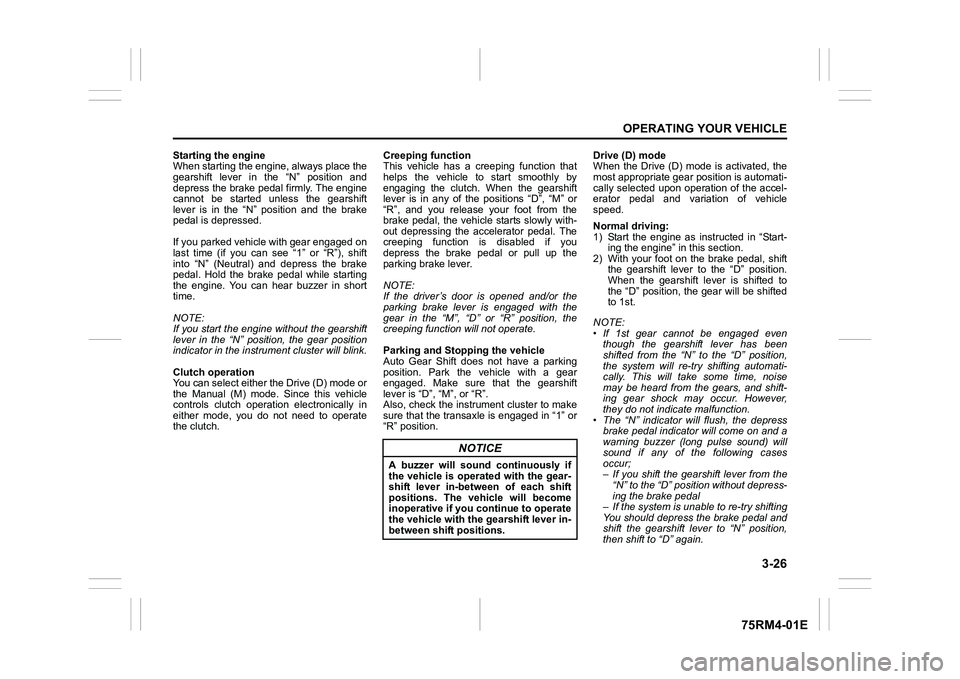
3-26
OPERATING YOUR VEHICLE
75RM4-01E
Starting the engine
When starting the engine, always place the
gearshift lever in the “N” position and
depress the brake pedal firmly. The engine
cannot be started unless the gearshift
lever is in the “N” position and the brake
pedal is depressed.
If you parked vehicle with gear engaged on
last time (if you can see “1” or “R”), shift
into “N” (Neutral) and depress the brake
pedal. Hold the brake pedal while starting
the engine. You can hear buzzer in short
time.
NOTE:
If you start the engine without the gearshift
lever in the “N” position, the gear position
indicator in the instrument cluster will blink.
Clutch operation
You can select either the Drive (D) mode or
the Manual (M) mode. Since this vehicle
controls clutch operation electronically in
either mode, you do not need to operate
the clutch.Creeping function
This vehicle has a creeping function that
helps the vehicle to start smoothly by
engaging the clutch. When the gearshift
lever is in any of the positions “D”, “M” or
“R”, and you release your foot from the
brake pedal, the vehicle starts slowly with-
out depressing the accelerator pedal. The
creeping function is disabled if you
depress the brake pedal or pull up the
parking brake lever.
NOTE:
If the driver’s door is opened and/or the
parking brake lever is engaged with the
gear in the “M”, “D” or “R” position, the
creeping function will not operate.
Parking and Stopping the vehicle
Auto Gear Shift does not have a parking
position. Park the vehicle with a gear
engaged. Make sure that the gearshift
lever is “D”, “M”, or “R”.
Also, check the instrument cluster to make
sure that the transaxle is engaged in “1” or
“R” position.Drive (D) mode
When the Drive (D) mode is activated, the
most appropriate gear
position is automati-
cally selected upon operation of the accel-
erator pedal and variation of vehicle
speed.
Normal driving:
1) Start the engine as instructed in “Start- ing the engine” in this section.
2) With your foot on the brake pedal, shift the gearshift lever to the “D” position.
When the gearshift lever is shifted to
the “D” position, the gear will be shifted
to 1st.
NOTE:
• If 1st gear cannot be engaged even though the gearshift lever has been
shifted from the “N” to the “D” position,
the system will re-try shifting automati-
cally. This will take some time, noise
may be heard from the gears, and shift-
ing gear shock may occur. However,
they do not indicate malfunction.
• The “N” indicator will flush, the depress brake pedal indicator will come on and a
warning buzzer (long pulse sound) will
sound if any of the following cases
occur;
– If you shift the gearshift lever from the
“N” to the “D” position without depress-
ing the brake pedal
– If the system is unable to re-try shifting
You should depress the brake pedal and
shift the gearshift lever to “N” position,
then shift to “D” again.
NOTICE
A buzzer will sound continuously if
the vehicle is operated with the gear-
shift lever in-between of each shift
positions. The vehicle will become
inoperative if you continue to operate
the vehicle with the gearshift lever in-
between shift positions.
Page 181 of 505

3-28
OPERATING YOUR VEHICLE
75RM4-01E
Downhill
1) Depress the brake pedal and shift thegearshift lever to the “D” position. Make
sure that the gear is in 1st by checking
the gear position indicator.
2) Release the brake pedal and depress
the accelerator pedal slowly. Even if the
accelerator pedal is not depressed, the
clutch will be engaged when the vehicle
speed increases.
Using engine braking:
When driving on a downhill slope, down-
shifting is recommended. So you can use
engine braking.
By placing the gearshift lever in the “M”
position, the Manual (M) mode is selected,
and you can shift to a lower gear manually.
For details of downshift operation, refer to
“Upshift and downshift” in the “Manual (M)
mode”. Manual (M) mode
The gears are not shifted automatically. To
shift the transaxle, the driver must operate
the gearshift lever to
the “+” or “–” direc-
tion. As for conventional manual transaxle
vehicles, releasing the accelerator pedal a
little may help the transaxle to shift
smoothly.
Upshift and downshift:
Upshifting
75RM258
Pull the gearshift lever to the “+” direction
and release it. Every time the lever is oper-
ated, the transaxle is upshifting 1 step in
the order of 1st 2nd 3rd 4th 5th
gear. Downshifting
75RM259
Push the gearshift lever to the “–” direction
and release it. Every time the lever is oper-
ated, the transaxle is downshifted in the
order 5th
4th 3rd 2nd 1st gear.
The gear position is displayed on the gear
position indicator. The gear position indica-
tor shows the transaxle gear position.
Before starting off, always check the gear
position indicator to make sure that the
transaxle is engaged in 1st or reverse,
then depress the accelerator pedal.
NOTE:
• To downshift smoothly, the engine runs fast in some cases. This is done inten-
tionally by the system and is not mal-
function.
• When driving down a hill, downshift and use the engine braking appropriately. If
necessary, continuous downshifting is
Page 182 of 505
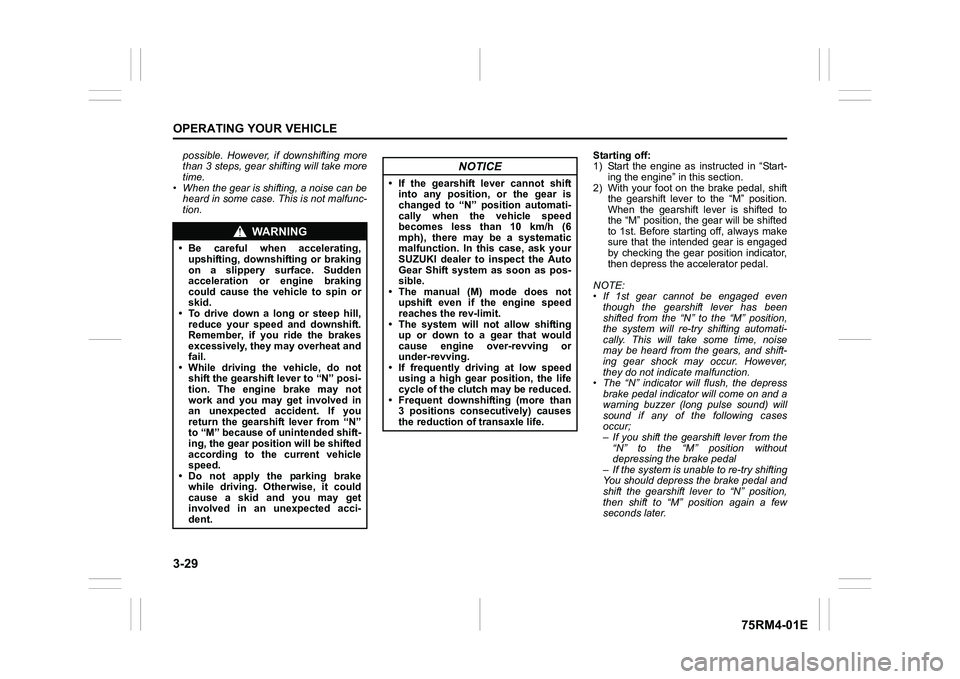
3-29OPERATING YOUR VEHICLE
75RM4-01E
possible. However, if downshifting more
than 3 steps, gear shifting will take more
time.
• When the gear is shifting, a noise can be heard in some case. This is not malfunc-
tion. Starting off:
1) Start the engine as instructed in “Start-
ing the engine” in this section.
2) With your foot on the brake pedal, shift the gearshift lever to the “M” position.
When the gearshift lever is shifted to
the “M” position, the gear will be shifted
to 1st. Before starting off, always make
sure that the intended gear is engaged
by checking the gear position indicator,
then depress the accelerator pedal.
NOTE:
• If 1st gear cannot be engaged even though the gearshift lever has been
shifted from the “N” to the “M” position,
the system will re-try shifting automati-
cally. This will take some time, noise
may be heard from the gears, and shift-
ing gear shock may occur. However,
they do not indicate malfunction.
• The “N” indicator will flush, the depress brake pedal indicator will come on and a
warning buzzer (long pulse sound) will
sound if any of the following cases
occur;
– If you shift the gearshift lever from the “N” to the “M” position without
depressing the brake pedal
– If the system is unable to re-try shifting
You should depress the brake pedal and
shift the gearshift lever to “N” position,
then shift to “M” position again a few
seconds later.
WA R N I N G
• Be careful when accelerating, upshifting, downshifting or braking
on a slippery surface. Sudden
acceleration or engine braking
could cause the vehicle to spin or
skid.
• To drive down a long or steep hill,
reduce your speed and downshift.
Remember, if you ride the brakes
excessively, they may overheat and
fail.
• While driving the vehicle, do not shift the gearshift lever to “N” posi-
tion. The engine brake may not
work and you may get involved in
an unexpected accident. If you
return the gearshift lever from “N”
to “M” because of unintended shift-
ing, the gear position will be shifted
according to the current vehicle
speed.
• Do not apply the parking brake
while driving. Otherwise, it could
cause a skid and you may get
involved in an unexpected acci-
dent.
NOTICE
• If the gearshift lever cannot shiftinto any position, or the gear is
changed to “N” position automati-
cally when the vehicle speed
becomes less than 10 km/h (6
mph), there may be a systematic
malfunction. In this case, ask your
SUZUKI dealer to inspect the Auto
Gear Shift system as soon as pos-
sible.
• The manual (M) mode does not
upshift even if the engine speed
reaches the rev-limit.
• The system will not allow shifting up or down to a gear that would
cause engine over-revving or
under-revving.
• If frequently driving at low speed using a high gear position, the life
cycle of the clutch may be reduced.
• Frequent downshif ting (more than
3 positions consecutively) causes
the reduction of transaxle life.
Page 183 of 505
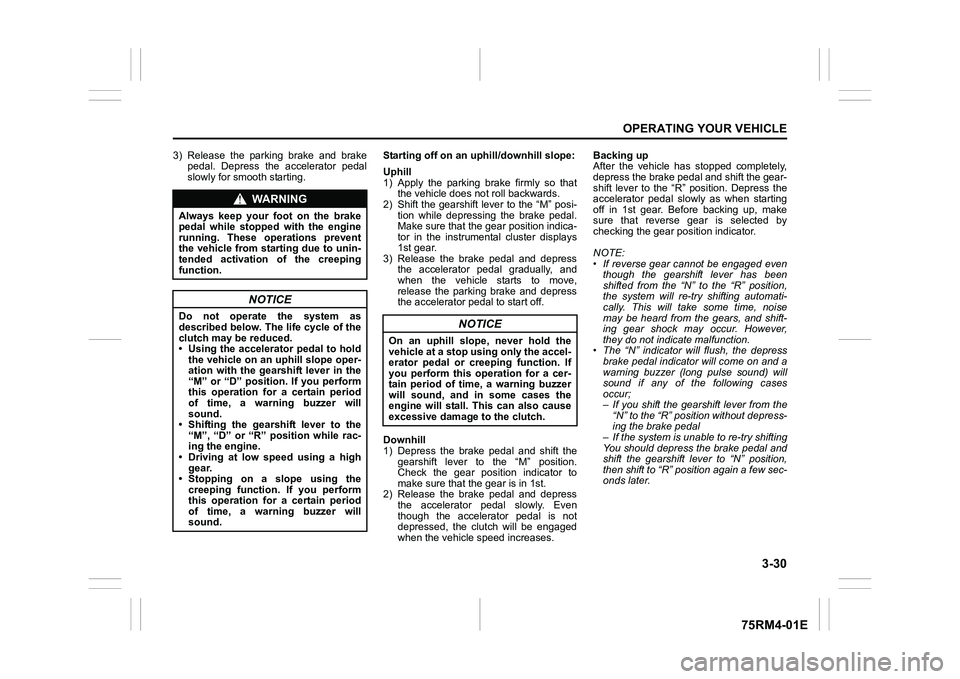
3-30
OPERATING YOUR VEHICLE
75RM4-01E
3) Release the parking brake and brakepedal. Depress the accelerator pedal
slowly for smooth starting. Starting off on an uphill/downhill slope:
Uphill
1) Apply the parking brake firmly so that
the vehicle does no t roll backwards.
2) Shift the gearshift lever to the “M” posi-
tion while depressing the brake pedal.
Make sure that the ge ar position indica-
tor in the instrumental cluster displays
1st gear.
3) Release the brake pedal and depress the accelerator pedal gradually, and
when the vehicle starts to move,
release the parking brake and depress
the accelerator pedal to start off.
Downhill
1) Depress the brake pedal and shift the gearshift lever to the “M” position.
Check the gear position indicator to
make sure that the gear is in 1st.
2) Release the brake pedal and depress the accelerator pedal slowly. Even
though the accelerator pedal is not
depressed, the clutch will be engaged
when the vehicle speed increases. Backing up
After the vehicle has stopped completely,
depress the brake pedal and shift the gear-
shift lever to the “R” position. Depress the
accelerator pedal slowly as when starting
off in 1st gear. Before backing up, make
sure that reverse gear is selected by
checking the gear position indicator.
NOTE:
• If reverse gear cannot be engaged even
though the gearshift lever has been
shifted from the “N” to the “R” position,
the system will re-try shifting automati-
cally. This will take some time, noise
may be heard from the gears, and shift-
ing gear shock may occur. However,
they do not indicate malfunction.
• The “N” indicator will flush, the depress brake pedal indicator will come on and a
warning buzzer (long pulse sound) will
sound if any of the following cases
occur;
– If you shift the gearshift lever from the “N” to the “R” position without depress-
ing the brake pedal
– If the system is unable to re-try shifting
You should depress the brake pedal and
shift the gearshift lever to “N” position,
then shift to “R” position again a few sec-
onds later.
WA R N I N G
Always keep your foot on the brake
pedal while stopped with the engine
running. These operations prevent
the vehicle from starting due to unin-
tended activation of the creeping
function.
NOTICE
Do not operate the system as
described below. The life cycle of the
clutch may be reduced.
• Using the accelerator pedal to hold the vehicle on an uphill slope oper-
ation with the gearshift lever in the
“M” or “D” position. If you perform
this operation for a certain period
of time, a warning buzzer will
sound.
• Shifting the gearshift lever to the
“M”, “D” or “R” po sition while rac-
ing the engine.
• Driving at low speed using a high
gear.
• Stopping on a slope using the creeping function. If you perform
this operation for a certain period
of time, a warning buzzer will
sound.
NOTICE
On an uphill slope, never hold the
vehicle at a stop using only the accel-
erator pedal or creeping function. If
you perform this operation for a cer-
tain period of time, a warning buzzer
will sound, and in some cases the
engine will stall. This can also cause
excessive damage to the clutch.
Page 184 of 505
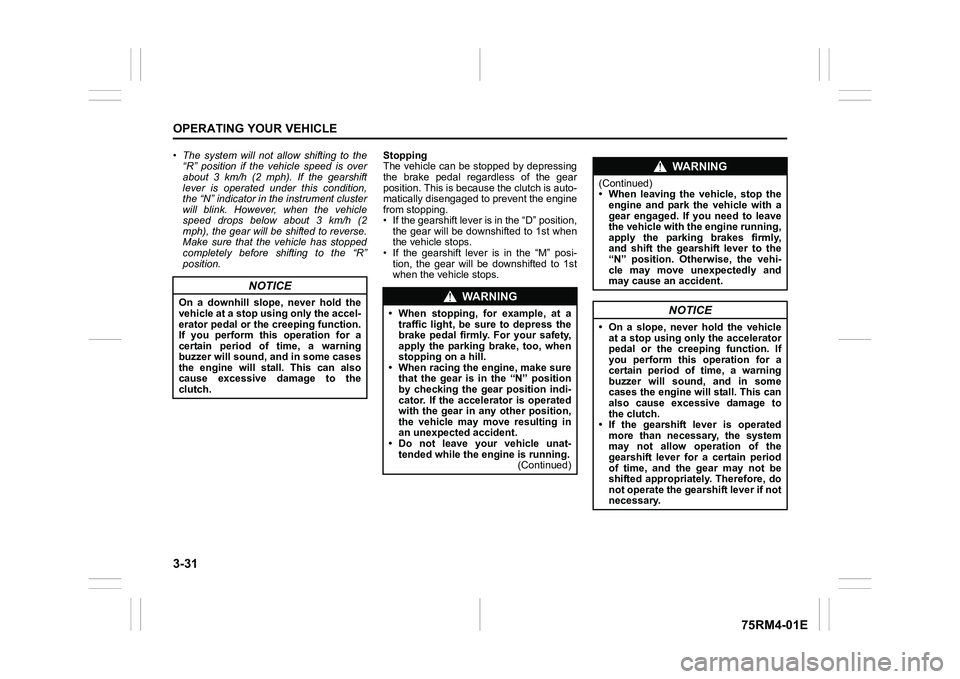
3-31OPERATING YOUR VEHICLE
75RM4-01E
• The system will not allow shifting to the“R” position if the vehicle speed is over
about 3 km/h (2 mph). If the gearshift
lever is operated under this condition,
the “N” indicator in the instrument cluster
will blink. However, when the vehicle
speed drops below about 3 km/h (2
mph), the gear will be shifted to reverse.
Make sure that the vehicle has stopped
completely before shifting to the “R”
position. Stopping
The vehicle can be stopped by depressing
the brake pedal regardless of the gear
position. This is because the clutch is auto-
matically disengaged to prevent the engine
from stopping.
• If the gearshift lever is in the “D” position,
the gear will be downshifted to 1st when
the vehicle stops.
• If the gearshift lever is in the “M” posi- tion, the gear will be downshifted to 1st
when the vehicle stops.
NOTICE
On a downhill slope, never hold the
vehicle at a stop using only the accel-
erator pedal or the creeping function.
If you perform this operation for a
certain period of time, a warning
buzzer will sound, and in some cases
the engine will stall. This can also
cause excessive damage to the
clutch.
WA R N I N G
• When stopping, for example, at a
traffic light, be sure to depress the
brake pedal firmly. For your safety,
apply the parking brake, too, when
stopping on a hill.
• When racing the engine, make sure that the gear is in the “N” position
by checking the gear position indi-
cator. If the accelerator is operated
with the gear in any other position,
the vehicle may move resulting in
an unexpected accident.
• Do not leave your vehicle unat-
tended while the engine is running. (Continued)
WA R N I N G
(Continued)
• When leaving the vehicle, stop the
engine and park the vehicle with a
gear engaged. If you need to leave
the vehicle with the engine running,
apply the parking brakes firmly,
and shift the gearshift lever to the
“N” position. Otherwise, the vehi-
cle may move unexpectedly and
may cause an accident.
NOTICE
• On a slope, never hold the vehicleat a stop using only the accelerator
pedal or the creeping function. If
you perform this operation for a
certain period of time, a warning
buzzer will sound, and in some
cases the engine will stall. This can
also cause excessive damage to
the clutch.
• If the gearshift lever is operated
more than necessary, the system
may not allow operation of the
gearshift lever for a certain period
of time, and the gear may not be
shifted appropriately. Therefore, do
not operate the gearshift lever if not
necessary.
Page 185 of 505

3-32
OPERATING YOUR VEHICLE
75RM4-01E
Parking
Unlike an automatic transaxle, Auto Gear
Shift does not have a parking position.
Park the vehicle with a gear engaged.
1) Apply the parking brake firmly.
2) While depressing the brake pedal, shift
the gearshift lever to the “R” position on
a downhill slope, and to the 1st position
in the drive (D) mode or the “M” position
in the manual (M) mode on an uphill
slope and confirm the gear position by
checking the gear position indicator.
3) Stop the engine.
NOTE:
• After the engine is stopped, the gear in the transaxle does not change even if
you shift the gearshift lever in any posi-
tion. Always shift the gearshift lever
before stop the engine.
• Check the transaxle gear position by looking at the gear position indicator,
then turn the ignition switch to “LOCK”
position or press the engine switch to
change the ignition mode to LOCK
(OFF), to stop the engine. Release the
brake pedal after a few seconds. Parking cancel
Depress the brake pedal, turn the ignition
switch to “ON” position or press the engine
switch to change the ignition mode to ON,
and shift the gearshift lever to the “N” posi-
tion. The gear will be disengaged. Warning functions
A warning buzzer will sound or the indica-
tor will blink under the f
ollowing conditions.
Warning buzzer
• The clutch is heated due to excessive load.
• The creeping function is being activated for a long period of time.
• The ignition switch is turned to the “LOCK” position or the engine switch is
pressed to change the ignition mode to
LOCK (OFF) with the gear in 2nd, 3rd,
4th or 5th. In this case, turn the ignition
switch to “ON” position or press the
engine switch to change the ignition
mode to ON, and shift the gearshift lever
in the “N” position, shift it to the “D” or
“M” or “R” position, t hen turn the ignition
switch to “LOCK” position or press the
engine switch to change the ignition
mode to LOCK (OFF).
• During a stop, the driver’s door is opened with the gearshift lever in the
“R”, “D” or “M” positi on while the engine
is running.
WA R N I N G
• If the gear is not engaged properly and completely before the ignition
switch is turned to “LOCK” posi-
tion or the engine switch is pressed
to change the ignition mode to
LOCK (OFF), the vehicle may not
be parked with the gear engaged.
Always confirm the gear position
by checking the gear position indi-
cator when parking.
• On a downhill slope, the gear
should be put in reverse, and in 1st
gear on an uphill slope. Otherwise,
the vehicle may move, and cause
an unexpected accident. If the gear
is left in the “N” position, the vehi-
cle cannot be parked with a gear
engaged.
NOTICE
In the above cases, pull over to the
side of the road and stop the engine,
and then ask your SUZUKI dealer to
inspect your vehicle. Otherwise, the
clutch disc may be damaged.
Page 199 of 505
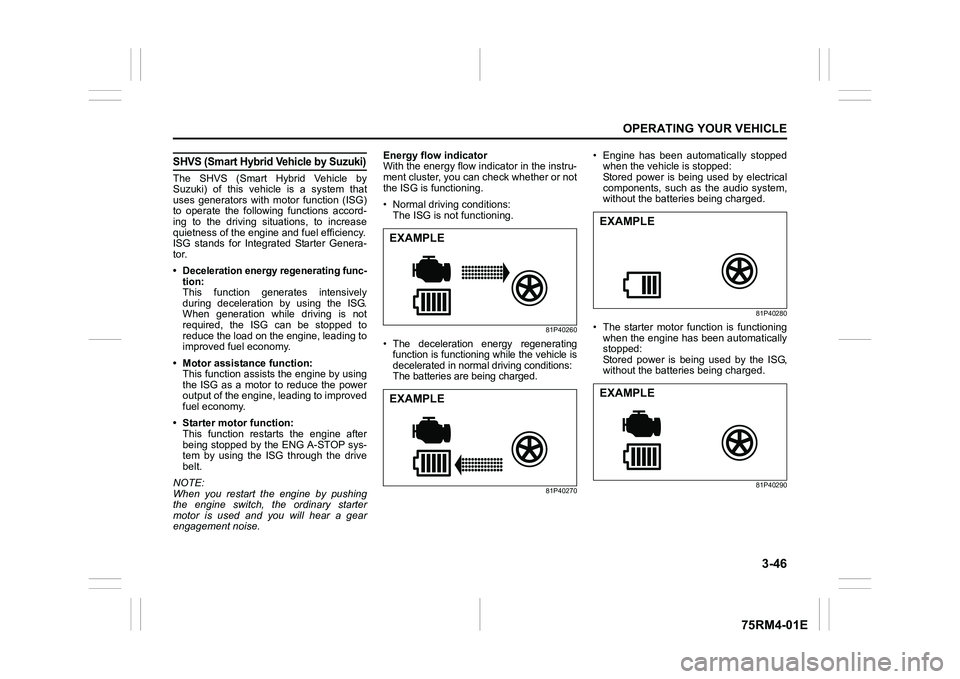
3-46
OPERATING YOUR VEHICLE
75RM4-01E
SHVS (Smart Hybrid Vehicle by Suzuki)The SHVS (Smart Hybrid Vehicle by
Suzuki) of this vehicle is a system that
uses generators with motor function (ISG)
to operate the following functions accord-
ing to the driving situations, to increase
quietness of the engine and fuel efficiency.
ISG stands for Integrated Starter Genera-
tor.
•Deceleration energy regenerating func-
tion
:
This function generates intensively
during deceleration by using the ISG.
When generation while driving is not
required, the ISG can be stopped to
reduce the load on the engine, leading to
improved fuel economy.
• Motor assistance function: This function assists the engine by using
the ISG as a motor to reduce the power
output of the engine, leading to improved
fuel economy.
• Starter motor function: This function restarts the engine after
being stopped by the ENG A-STOP sys-
tem by using the ISG through the drive
belt.
NOTE:
When you restart the engine by pushing
the engine switch, the ordinary starter
motor is used and you will hear a gear
engagement noise. Energy flow indicator
With the energy flow indicator in the instru-
ment cluster, you can check whether or not
the ISG is functioning.
• Normal driving conditions:
The ISG is not functioning.
81P40260
• The deceleration energy regeneratingfunction is functioning while the vehicle is
decelerated in normal driving conditions:
The batteries are being charged.
81P40270
• Engine has been aut omatically stopped
when the vehicle is stopped:
Stored power is being used by electrical
components, such a s the audio system,
without the batteries being charged.
81P40280
• The starter motor function is functioning when the engine has been automatically
stopped:
Stored power is being used by the ISG,
without the batteries being charged.
81P40290
EXAMPLEEXAMPLE
EXAMPLEEXAMPLE
Page 206 of 505
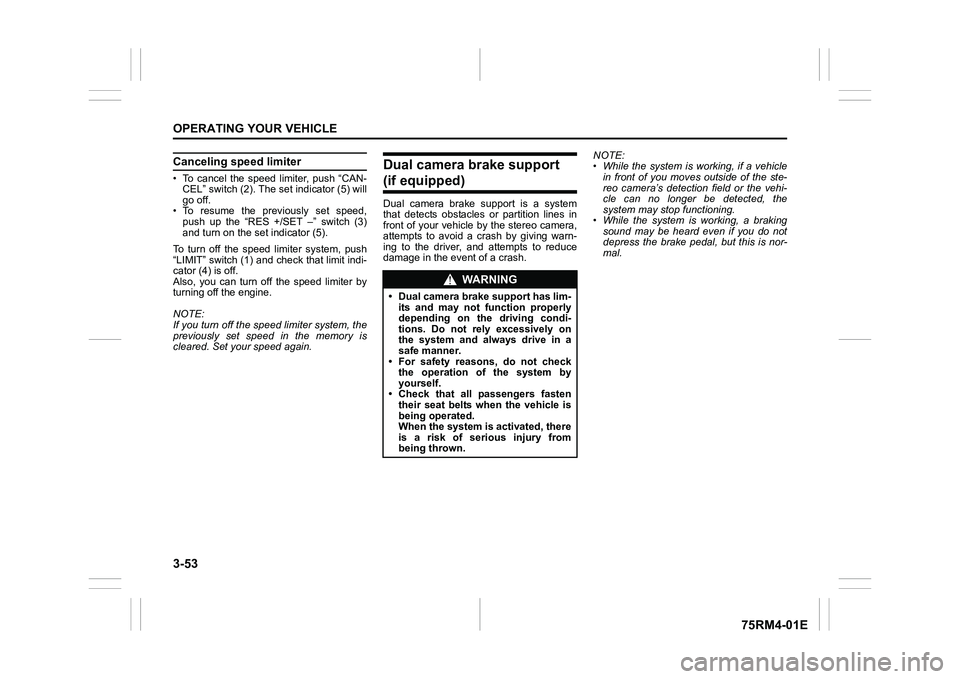
3-53OPERATING YOUR VEHICLE
75RM4-01E
Canceling speed limiter• To cancel the speed limiter, push “CAN-CEL” switch (2). The set indicator (5) will
go off.
• To resume the previously set speed, push up the “RES +/SET –” switch (3)
and turn on the set indicator (5).
To turn off the speed limiter system, push
“LIMIT” switch (1) and check that limit indi-
cator (4) is off.
Also, you can turn off the speed limiter by
turning off the engine.
NOTE:
If you turn off the speed limiter system, the
previously set speed in the memory is
cleared. Set your speed again.
Dual camera brake support (if equipped)Dual camera brake support is a system
that detects obstacles or partition lines in
front of your vehicle by the stereo camera,
attempts to avoid a crash by giving warn-
ing to the driver, and attempts to reduce
damage in the event of a crash. NOTE:
• While the system is working, if a vehicle
in front of you moves outside of the ste-
reo camera’s detection field or the vehi-
cle can no longer be detected, the
system may stop functioning.
• While the system is working, a braking sound may be heard even if you do not
depress the brake pedal, but this is nor-
mal.
WA R N I N G
• Dual camera brake support has lim-its and may not function properly
depending on the driving condi-
tions. Do not rely excessively on
the system and always drive in a
safe manner.
• For safety reasons, do not check the operation of the system by
yourself.
• Check that all passengers fasten their seat belts when the vehicle is
being operated.
When the system is activated, there
is a risk of serious injury from
being thrown.
Page 212 of 505
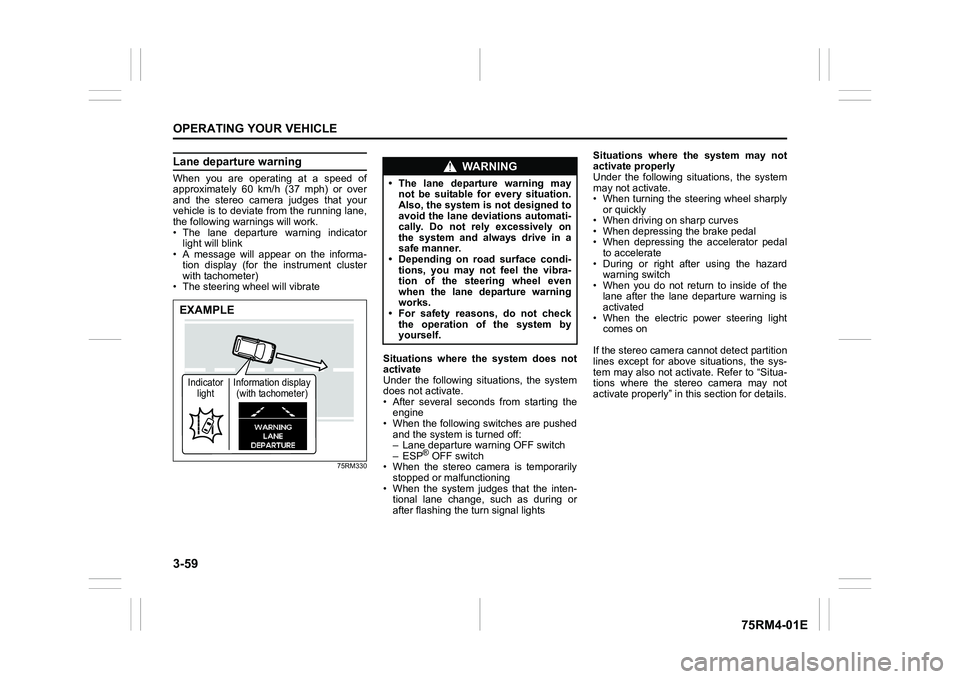
3-59OPERATING YOUR VEHICLE
75RM4-01E
Lane departure warningWhen you are operating at a speed of
approximately 60 km/h (37 mph) or over
and the stereo camera judges that your
vehicle is to deviate from the running lane,
the following warnings will work.
• The lane departure warning indicatorlight will blink
• A message will appear on the informa-
tion display (for the instrument cluster
with tachometer)
• The steering wheel will vibrate
75RM330
Situations where the system does not
activate
Under the following situations, the system
does not activate.
• After several seconds from starting the engine
• When the following switches are pushed and the system is turned off:
– Lane departure warning OFF switch
– ESP
® OFF switch
• When the stereo camera is temporarily stopped or malfunctioning
• When the system judges that the inten- tional lane change, such as during or
after flashing the turn signal lights Situations where the system may not
activate properly
Under the following situations, the system
may not activate.
• When turning the steering wheel sharply
or quickly
• When driving on sharp curves
• When depressing the brake pedal
• When depressing the accelerator pedal to accelerate
• During or right after using the hazard warning switch
• When you do not return to inside of the lane after the lane departure warning is
activated
• When the electric power steering light comes on
If the stereo camera cannot detect partition
lines except for above situations, the sys-
tem may also not activ ate. Refer to “Situa-
tions where the stereo camera may not
activate properly” in this section for details.
EXAMPLEIndicator light Information display
(with tachometer)
WA R N I N G
• The lane departure warning may not be suitable for every situation.
Also, the system is not designed to
avoid the lane deviations automati-
cally. Do not rely excessively on
the system and always drive in a
safe manner.
• Depending on road surface condi-
tions, you may not feel the vibra-
tion of the steering wheel even
when the lane departure warning
works.
• For safety reasons, do not check
the operation of the system by
yourself.